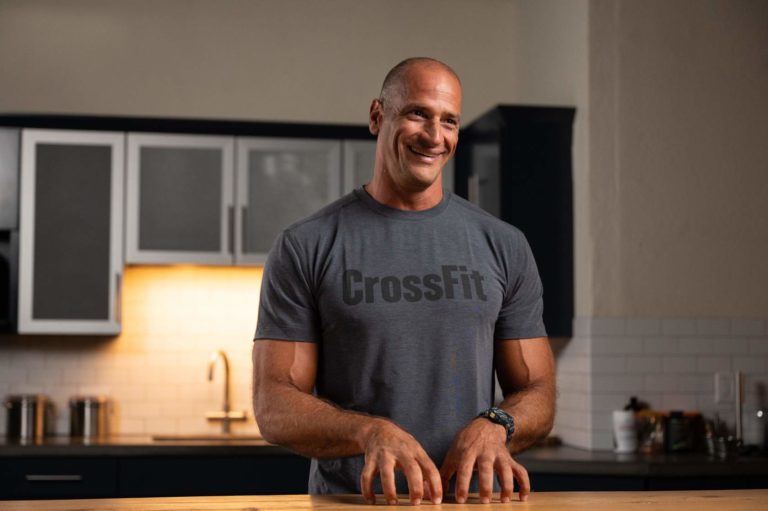The goal of CrossFit has always been to forge elite fitness — that is, to increase our work capacity across broad time and modal domains. In simpler terms, it means developing the ability to perform well in any physical task, workout, job, or sport. We train for this — building fitness in the gym so we can use it outside the gym.
The methodology we use to build such impressive levels of all-around fitness consists of constantly varied functional movements executed at high intensity. We bike, run, swim, row, jump, snatch, clean, jerk, squat, deadlift, press, and do all kinds of gymnastics movements. We mix these exercises into infinite workout options of long, short, and medium duration, heavy, light, and medium loading, high, medium, and low reps, and varied structures such as single modality days, couplets, triplets, and chippers. Our diet recommendation rounds out the CrossFit methodology: “Eat meat and vegetables, nuts and seeds, some fruit, little starch, and no sugar. Keep intake to levels that will support exercise but not body fat.” In practice, this potent version of “diet and exercise” produces unmatched levels of fitness.
In addition to bestowing the ability to kick butt generally, CrossFit is also famous all over the world for another common, desirable side effect. CrossFit produces amazing physiques in both men and women. Founder Greg Glassman called this “a functional aesthetic that is uniquely ours … the look of enormous work capacity across broad time and modal domains … the look of true performance. This happens when form, as it should and will, follows function. What we’ve made, what you’ll see all around you … is a better beautiful.”
The physiques of many of today’s bodybuilders and fitness competitors — fueled by extended periods of unhealthy calorie restriction, dangerous pharmacology, and non-functional hypertrophy — have distorted what the general public views as a realistic expression of a healthy, fit, capable body. These physique athletes are actually quite unhealthy and have very low capacity by CrossFit standards. In years past, at Level 1 Certificate Courses, we would jokingly refer to the stereotypical bodybuilder as a “Display Model Only” — all show and no go.
Quite to the contrary, the impressive physiques of CrossFit athletes trace their lineage back to the Golden Era of bodybuilding from the 1920s through the 1950s, when bodybuilders were athletes first. They were strongmen who performed incredible feats of strength on stage and trained with heavy globe barbells and dumbbells, odd objects, and gymnastics movements, including handstands and ring work.
Icons of American bodybuilding, such as Tommy Kono (Mr. Universe 1954, 1955,1957, and 1961) and John Grimek (Mr. America 1940, 1941, and Mr. Universe 1948) competed on the U.S. Olympic Weightlifting team. Grimek was America’s heavyweight champion and competed at the 1936 Olympic Games. Kono is considered one the greatest weightlifters of all time, winning Olympic gold in Helsinki in 1952 and Melbourne in 1956, and capping off an amazing career with the silver medal in Rome in 1960.
Again, the tremendous physiques these men built were the product of the training they did for their sport, consisting of a wide variety of squats, cleans, snatches, presses, and a myriad of dumbbell and gymnastics movements to build full body strength. At a bodyweight of 165 pounds, Kono could press 285 lb, snatch 280 lb, and clean and jerk 350 lb. His physique was a prime example of form following function.
Building an attractive physique — looking good naked — is a common goal for many men and women I talk to about training and nutrition. I don’t have a “secret” method to get them where they want to be. People who do CrossFit regularly look like athletes because they train like athletes. I tell them building the type of body they dream of requires lifting heavy, challenging loads regularly in squats, presses, deadlifts, cleans, snatches, and jerks. I emphasize their training should also regularly include high-intensity intervals or circuits consisting of these same weightlifting movements, as well as other very effective exercises such as push-ups, pull-ups, dips, swings, biking, rowing, running, lunging, jumping, and burpees where they push to discomfort. They should round their training out with occasional, longer, less intense efforts such as jogging, rucking, swimming, and any sport they enjoy dabbling in.
I tell them the high-intensity intervals and judiciously applied “aerobic” work not only assist with burning fat and preserving muscle, they also develop the capacity needed to support the intensity and volume of work required on “heavy” days to build the muscle and strength we need to thrive.
Combining all these modalities creates an incredible, perpetual cycle of increasing fitness across a broad spectrum of physical challenges. Complement this training with a diet consisting of whole, unprocessed foods eaten in the right amounts, and we end up with an athlete who not only performs incredibly well but looks the part, too — a better beautiful.
That’s my clumsy elevator pitch. I like this version better: “If you want to get incredibly fit and have the body to match, do CrossFit. Trust me now, and thank me later.”
About the Author
 Stephane Rochet is a Senior Content Writer for CrossFit. He has worked as a Flowmaster on the CrossFit Seminar Staff and has over 15 years of experience as a collegiate/tactical strength and conditioning coach. He is a Certified CrossFit Trainer (CF-L3) and enjoys training athletes in his garage gym.
Stephane Rochet is a Senior Content Writer for CrossFit. He has worked as a Flowmaster on the CrossFit Seminar Staff and has over 15 years of experience as a collegiate/tactical strength and conditioning coach. He is a Certified CrossFit Trainer (CF-L3) and enjoys training athletes in his garage gym.
The CrossFit Physique: When Performance Builds a Better Body